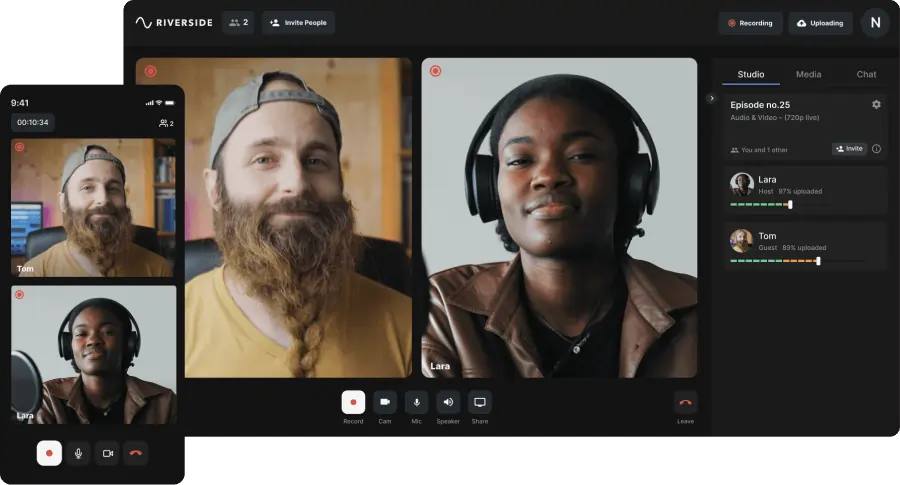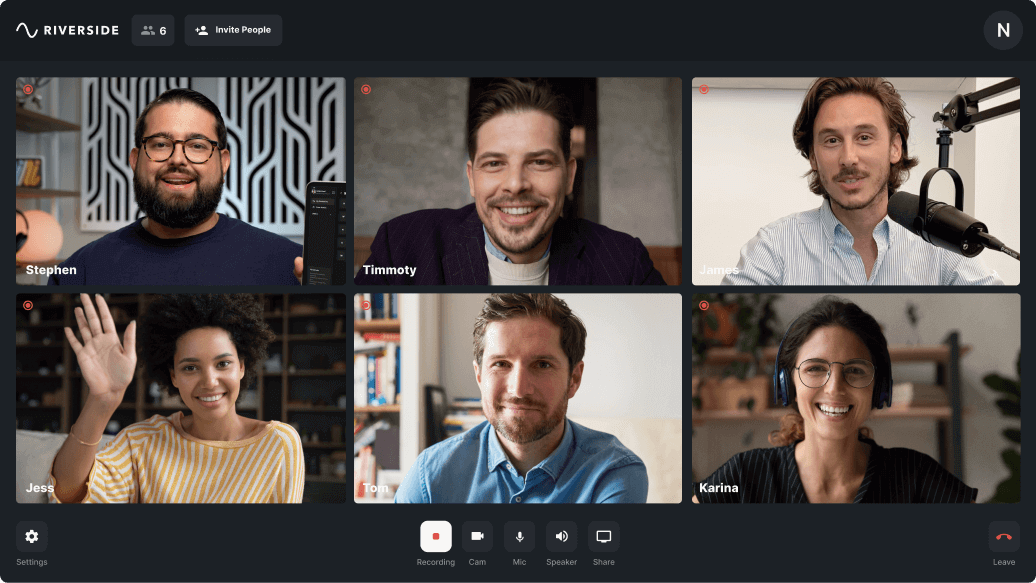Are you thinking about trying out pre-recorded webinars and want to know more about them?
That’s great, as pre-recorded webinars are an important part of a good webinar marketing strategy.
In this article, we’ll look at how pre-recorded webinars differ from standard live webinars, their benefits, and how to make a pre-recorded webinar work.
Let’s get in.
What is a pre-recorded webinar?
A pre-recorded webinar is one that has been recorded in advance and made available for viewing at a later date. During the recording of the webinar, there’s no real-time audience, unlike a live webinar.
Pre-recorded webinars are often edited and polished before uploading. The attendees can then play them later at a convenient time.
Here is an example of how a registration page for a pre-recorded webinar looks like:
Live webinars vs recorded webinars
A live webinar takes place on a specific date and time. At that time, the host and the attendees interact with each other in a live setting.
In a pre-recorded webinar, the host just records the webinar and airs it multiple times later. In this webinar, there’s no interaction between the host and the attendees.
Pre-recorded webinars are easy to scale as they reach more people. Live webinars can’t do that.
Live webinar pros and cons
Pros
- Connection with the attendees: A live webinar enables the host and speakers to connect with their attendees. Both can share their stories. In this way, an emotional connection is built with the participants.
- No post-production: Post-production is a hassle, and live webinars save you that pain, as you don’t have to worry about editing them. Live webinars only need the personal and human touch to be successful. They don’t require high-production values.
Cons
- Technical difficulties: A poor internet connection or an unforeseen bug can derail a live webinar.
- Time difference: If you have a global audience, finding the right time to go live on the webinar isn’t easy. People from certain countries may not be able to watch your webinar because they’d be sleeping at that time. In this way, hosting live webinars may lose you some potential customers.
- Unexpected events: Often, our daily lives get interrupted by real-world events, like a dog barking or someone ringing the doorbell. When this happens during the live webinar, it can disrupt its flow.
Pre-recorded webinar pros and cons
Pros
- Planning: With a pre-recorded webinar, you can plan the content and stick to the script. In this way, you can deliver the information in a more structured and effective way.
- Editing: Every video has some clunky sections that take away from the overall quality. However, with pre-recorded videos, it’s easy to edit out these sections and keep only the streamlined and engaging bits. You can also add pictures, videos, and other media to the original video to make the content more informative.
- Re-recording sections: If there’s a section that could be better delivered, you can rerecord that and splice it into the original video.
- Less pressure: Speaking in front of a live audience can be daunting, so pre-recorded webinars remove that extra pressure.
Cons
- Less connection with your audience: Compared to live webinars, pre-recorded webinars don’t foster a sense of community and connection.
- Cannot respond to feedback: During live webinars, if the attendees have some valuable feedback that could improve the webinar, the host can implement it immediately. The same can’t be done with pre-recorded webinars — you can only respond to customer feedback by creating a new webinar, or editing the original one.
Why should you use pre-recorded webinars?
Pre-recorded webinars should be used to augment your company’s webinar marketing strategy. In conjunction with live webinars, they give you the most optimal strategy to regain more customers.
Benefits of pre-recorded webinars
- Unlimited scaling: Reach an unlimited amount of people. A pre-recorded webinar helps reach a larger audience as you can air the webinar at a time that’s ideal for different people in different countries.
- Cost efficient: You don’t have to record a pre-recorded webinar multiple times, unlike a live webinar. One record can serve you a lifetime.
- Consistency: You just need to record the webinar once. After that, you will get a consistent and continuous flow of new customers.
How to create successful pre-recorded webinars?
Let’s look at how to create pre-recorded webinars that are successful in attracting new clients and customers.
Step 1: Decide what the webinar topic should be
Find a topic that’ll likely convert people after they watch your webinar.
Here are some ways to do so:
- Find out your customers' most popular questions: Make a list of the most popular questions asked by your customers. You can find these by asking your sales team and by seeing the comments on your blog and social media.
- Set up polls: Conducting polls is a great way to know what your customers actually want.
- Spy on the competitors: By looking at your competitors, you can see what topics are popular with their customer base. You can steal these topics — just make sure your take on the topic is better and that your angle is still original.
- Past webinar questions: If you’ve already conducted a webinar, you can use past questions from webinar attendees to inform future topics.
Step 2: Prepare the Webinar Script
The next step would be to prepare a script — one that’s ideally around 30-45 minutes long.
Here’s a general format for a good script:
- Introduction: This sets the stage for the rest of the webinar. Introduce yourself, the business, and the topic.
- Set the agenda: Next, explain the webinar's agenda and let your audience know what they’ll be learning. You should make clear that you have juicy content in store for the audience, or they may tune off early.
- Explain the importance of the topic: Here, you’ll have to talk about ‘why’ the topic is important. You can also talk about how the attendees will benefit from the topic
- Educational content: This is where you'll get to the meat of the content. The information in this part is the reason your audience joined the webinar. Here you can use slides, images, pictures, and video to explain the topic. You can also add relevant stories to keep things interesting, as no one wants to listen to a bunch of facts the whole time. Also. let the audience know how your product can solve their problem. And if you have a product to sell, this is the section where you’ll pitch it to the attendees.
- Conclusion: Recap all the points and present key takeaways. Also, have CTAs that will fulfill your marketing goals.
Step 3: Record Your Presentation
Once the script’s done, start recording the webinar!
Your steps to record your webinar may be a little different based on the software you’re using. In short, you’ll most likely just have to press a record button once you’re all set up.
If you want to record webinars in high-quality 4K, then Riverside is great platform.
Read more: How To Record a Webinar in High-Quality on Any Device (2022).
Step 4: Add a good CTA
End every webinar with a CTA, to ensure that your audience takes some action towards your marketing goals.
And since it is a pre-recorded webinar, you can A/B split test different CTAs to see what works better.
Step 5: Schedule the webinar at the right time
Make sure to schedule the webinar at a time that’s convenient for different people across the globe.
The most convenient time for most time zones would be either at 11 am or 2 pm. This way, you’ll avoid the lunch hour.
Step 6: Promote your webinar
Get as many people as possible to know about your webinar. You can do this by:
- Spreading word social media
- Collaborating with influencers to gain new potential customers
- Informing the people on your mailing list
- Running ads
Read more: How to Create a Webinar: 12 Easy Steps to Success
Best pre-recorded webinar platform: Riverside

Video and production quality need to be high for pre-recorded webinars. Low res videos can make your brand seem outdated and possibly unprofessional.
Therefore, you’ll need a webinar platform with more than 720p or 1080p capability. That’s where Riverside comes in. It helps you record your webinar in up to 4K, giving you the sharpest, most clear quality video.
Setting up a webinar on Riverside is easy. And once you get your webinar up and running, you can invite guests with a link.
The webinar videos are recorded locally on your computer rather than on the cloud. In this way, even if there are internet issues, your webinar won’t be affected.
Another reason Riverside is an excellent choice for prerecorded webinars is the Media Board. This feature lets you insert audio and video clips into the live webinar, live, increasing your webinar's production value.
Key Features
- Up to 4K video for crisp, high-definition video.
- Uncompressed 48kHz WAV audio for crystal clear audio.
- Separate audio and video tracks recorded for every guest, so post-production is a breeze.
- Local recording so all files are captured directly on your device instead of relying on faulty internet connection.
- Live stream and broadcast option to social media platforms like LinkedIn, YouTube, Facebook, Twitch, and Twitter.
- iOS and Android mobile app for recording on the go.
- Text-based editing where trimming your recording is as easy as deleting text
- Automated features to customize your layout and background, remove background noise or silences, plus more.
- Magic Clips tool to repurpose a single webinar into multiple shareable social media clips
- Multiple aspect ratio options (Story - vertical 9:16, Post - Square 1:1, Full Length - widescreen 16:9) to choose from, so your video is ready for most platforms.
- Producer mode so you can invite someone behind-the-scenes to keep control of technicalities without being recorded.
- Media board for live editing and sound effects.
Start experiencing all these benefits and more! Start recording on Riverside.
FAQs on Recorded Webinars
How do I watch a recorded webinar?
To watch a recorded webinar, open the link that the organizer sends you to your mail inbox and follow the instructions provided.
What is a pre-recorded webinar called?
Pre-recorded webinars are also called on-demand webinars, they can be accessed at any time. You can also call pre-recorded webinars evergreen webinars.
Is a recorded webinar considered live?
No, a recorded webinar isn’t considered live. It is pre-recorded beforehand and doesn’t have a live audience during filming.
How do I share a recorded webinar?
To share a recorded webinar, go to the video in your respective webinar recording software to find a shareable link. Then share this link to anyone via email, website, social media, or other online avenues.
Can I pre-record a webinar?
Yes, you can pre-record a webinar. Other than live webinars, the most popular type of webinars are pre-recorded ones.
To learn how to pre-record a webinar, you can read our guide here.




%20(1).webp)










-(1).png)
-Event.png)
.png)



